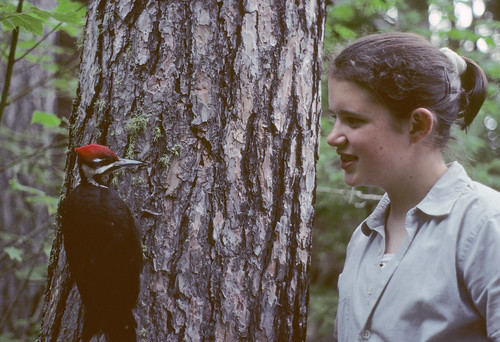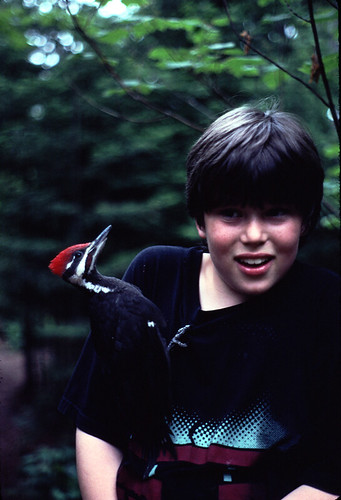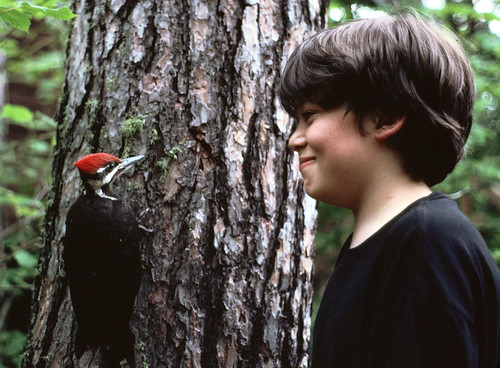In 1998, someone in Two Harbors brought me a newly-fledged baby Pileated Woodpecker that had been hit by a car. The bird had a minor wing sprain and no experience yet in getting his own food, but like most woodpecker fledglings was full grown.
I’d never before touched a Pileated Woodpecker, much less held one in my hands (though now that I think of it, I had been pooped on by one long ago). You can’t help but look at that huge beak and think about how easily it can hack into a hardwood tree—I found myself wondering what kind of damage it could do to me. But from the start, Geppetto was extraordinarily and unfailingly gentle.
Baby pileateds take food by pulling a parent’s bill into their own and, pumping their head back and forth, stimulate the adult to regurgitate its stomach contents down the baby’s throat. Much as I want to protect baby birds from hunger, I’m neither equipped nor inclined to go to that extreme to feed one. Fortunately, I didn’t need to. I whipped up a slurry of high-protein baby food developed for feeding baby parrots and fed Geppetto with an eyedropper, which happened to be the length of a Pileated Woodpecker’s bill. He grabbed it in his bill and pumped his head back and forth, and I squeezed the bulb. He took to this so instantaneously that it must have seemed at least a little close to what he’d been expecting.
His wing healed very quickly, but there was no way of reconnecting him with his parents, and he wasn’t nearly ready to fend for himself yet. Fledgling pileateds stick close to their parents even as they start exploring the big world—we humans may think we invented education, but birds have been educating their young long before we emerged from the evolutionary ooze. Several times I took Geppetto to an anthill in my backyard. Pileateds eat a lot of ants, apparently enjoying the formic acid taste, and sure enough, Geppetto pigged out. At such close range, I could watch him extend his long tongue and reel it in with half a dozen or more ants along the sticky surface. This was before I was taking many photos—I so wish I had photos and video of this! When he was sated, he’d hop over or, as his wing improved, fly over, and climb up my pants leg to perch on my arm.
That was his favorite spot—my arm. He often hitched his way up and stood with his feet on my shoulder and his beak less than an inch from my ear. He never stuck his beak into it, but he frequently extended his long, flexible tongue, tracing every fold of my ear in a most optimistic way. I trust he never found any bugs in there, but nevertheless he persisted.
I had him at home only ten days or so before I was scheduled to teach a two-week Elderhostel class up at Camp Du Nord on Burntside Lake, just outside the Boundary Waters. Katie and Tommy were coming along, and we decided that would be the perfect place to slowly "hack out" Geppetto, subsidizing him with food and protection as he learned to be wild.
To transport him to the camp, I put an open box on the front passenger seat with a thick 2- or 3-foot long birch branch sticking up. He perched on that the whole ride, looking out the window with interest. We went through some construction on Highway 1, and I can still remember driving along at a snail's pace, construction workers and people in cars going the opposite way staring at Geppetto, the little guy staring right back.
At camp, he stuck near us for the first several days and was even more clingy than he’d have normally been because the territorial adults of a nearby pileated family kept chasing him. At some point he realized that when he flew to me, they disappeared, and after that, a couple of times he actually seemed to approach them to get them to chase him. Then he’d fly straight to me and face them as if taunting, “My mom’s bigger than your mom.” That seemed to work—they stopped harassing him. (I saw this exact thing in one other bird I rehabbed, a baby Blue Jay when I was back in Madison, Wisconsin.)
I couldn't show him how to slam his face into a tree to root out bugs, but I did bring him to several trees I’d seen the other pileateds working in, and he quickly picked up the idea that there were wood-boring beetle grubs and carpenter ants in there and he could dig them out. He was still flying to me and my kids for meals, but that didn’t surprise me at all—I’ve watched fledglings with a parent before. The babies start figuring out how to get their own food, but until they grow proficient, they can't help but grow impatient and start begging again, and the parents seem always to indulge them. In the same way, Geppetto was figuring out how to find food while secure in the knowledge that he wouldn’t get too hungry with us to depend on.
Just in case he got into trouble, I left some food with the camp program director, who later told me that he thought he saw Geppetto a few times but couldn’t be sure. It’s an unsettling and bittersweet feeling to stop seeing a beloved bird, knowing he’s probably but not definitely still out there, and hoping he's doing what wild Pileated Woodpeckers should be doing. As we drove away on Saturday, my kids and I looked back with sadness and hope. I whispered, “Farewell, Geppetto. Live long and prosper.”
And that was that. I hope he did live long and prosper. My own life was so much richer for having known and nurtured this magnificent creature, who made me the only person I’ve ever known who was French-kissed in the ear by a Pileated Woodpecker. Geppetto was the best bird EVER!!


